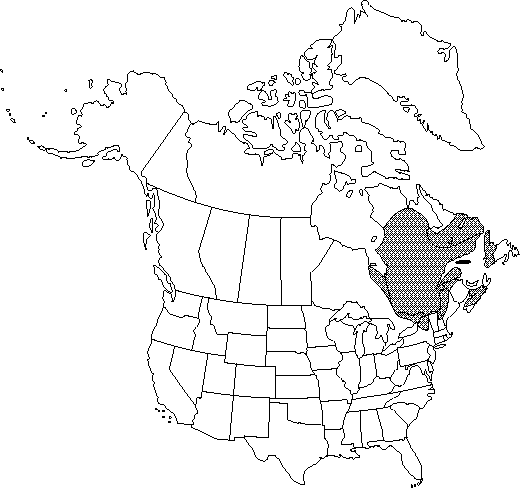Betula minor
Rhodora 47: 306. 1945.
Shrubs, erect, irregularly spreading, or depressed, to 5 m. Bark dark, reddish brown, smooth, close, not readily exfoliating; lenticels pale, horizontally expanded. Twigs without odor and taste of wintergreen, glabrous to sparsely pubescent, often dotted with resinous glands. Leaf blade ovate with 2–6 pairs of lateral veins, 1.5–5.5(–8) × 1.5–3(–5) cm, base rounded or cuneate to truncate, margins coarsely doubly serrate, teeth obtuse to rather sharp, toothed nearly to base, apex acute to obtuse; surfaces abaxially glabrous to moderately pubescent, usually more densely pubescent along major veins, often covered with small resinous glands. Infructescences erect, cylindric 1–3 × 0.5–1 cm, shattering with fruits in fall; scales glabrous to moderately pubescent, lobes diverging at middle, central lobe elongate, apex obtuse, lateral lobes ascending, as long as to nearly shorter and broader than central lobe. Samaras with wings equal to or broader than body, broadest near summit, extending beyond body apically. 2n = 56.
Phenology: Flowering late spring.
Habitat: Rocky slopes, barrens, and subalpine summits
Elevation: 1000–2000 m
Distribution

N.B., Nfld., N.S., Ont., Que., Maine, N.H., N.Y.
Discussion
The origin and relationships of this small birch have not been adequately determined. Betula minor resembles B. pubescens (as B. odorata Bechstein) of Greenland and northern Europe (M. L. Fernald 1950), and it has been combined into that species (A. Löve and D. Löve 1966). Northern and maritime populations of the complex have often been segregated as a separate species (B. borealis Spach sensu M. L. Fernald 1950; B. saxophila of E. Lepage 1976); the name B. minor has been mostly restricted to the subalpine form of northern Appalachian peaks. These two taxa actually constitute a single, somewhat variable, morphologic entity; they are indistinguishable by the minor character differences that have been used to separate them in the past. Because Spach's type of B. borealis consists of material of B. pumila (B. Boivin 1967b), that name must be rejected for this species.
Further complicating matters, E. Lepage (1976) concluded that the type of Betula minor represents a hybrid between individuals of the dwarf species and B. papyrifera, and on that basis, following nomenclatural rules, he renamed the dwarf species B. saxophila, retaining the name B. minor for the hybrid. Leaf shapes and other visible characters of the type fall easily within the limits of variation of B. saxophila, however, and the group is considered here to consist of a single entity, designated by the older name B. minor.
At least in the Adirondacks, Betula minor usually occurs near populations of B. cordifolia and B. glandulosa, and it has frequently been suggested (e.g., E. Hultén 1968; E. Lepage 1976; J. J. Furlow 1990) that it may have originated through hybridization between these species (perhaps followed by polyploidy). The northern populations may similarly consist of a hybrid swarm involving B. papyrifera or B. cordifolia and B. glandulosa. Critical examination of the entire complex, including experimental studies of the patterns of hybridization present, are necessary to unravel its problems satisfactorily.
Selected References
None.